What Is A Medical Term For The Phrase Surgical Repair Of Skin
6 Integumentary Organisation
- Identify the anatomy of the integumentary system
- Depict the principal functions of the integumentary system
- Spell the integumentary system medical terms and use correct abbreviations
- Identify the medical specialties associated with the integumentary system
- Explore mutual diseases, disorders, and procedures related to the integumentary organization
Integumentary System Word Parts
Click on prefixes, combining forms, and suffixes to reveal a list of word parts to memorize for the Integumentary System.
Introduction to the Integumentary System
The integumentary system refers to the skin and its accessory structures. In the adult homo body, the skin makes up about 16 percent of body weight and covers an area of 1.5 to two mii.
In fact, the skin and accessory structures are the largest organ arrangement in the human torso. The skin protects your inner organs and it is in need of daily care and protection to maintain its health.
Picket this video:
Media half-dozen.1. The Integumentary Arrangement, Part one – Skin Deep: Crash Course A&P #6 [Video]. Copyright 2022 by CrashCourse.
Exercise integumentary system medical terms.
Anatomy (Structures) of the Integumentary System
The skin and its accessory structures make up the integumentary system, which provides the body with overall protection. The skin is made of multiple layers of cells and tissues, which are held to underlying structures past connective tissue. The deeper layer of peel is well . Information technology as well has numerous sensory, and and nerve fibers ensuring advice to and from the brain.
The skin is composed of two main layers:
- The
- The
- Beneath the dermis lies the
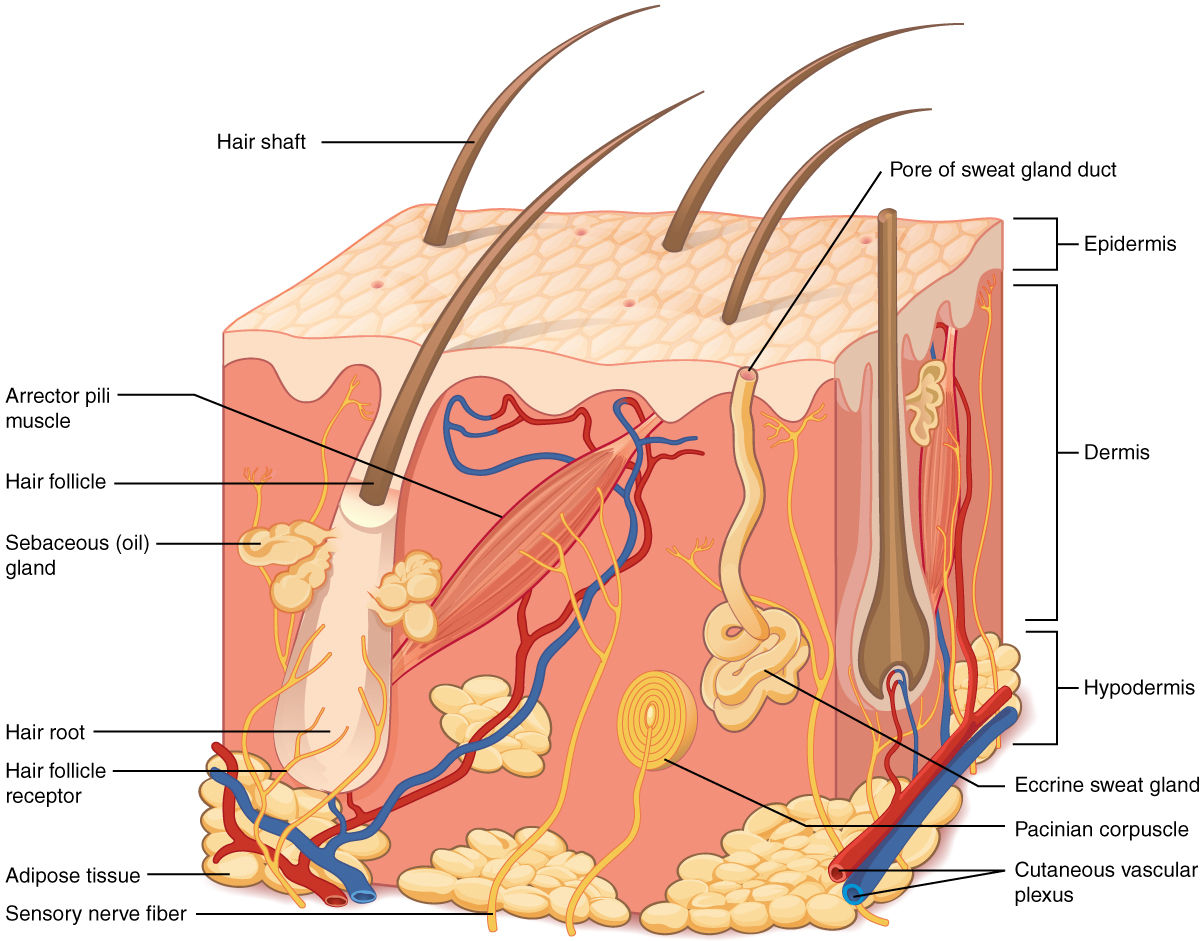
- On the diagram to a higher place find the two layers of the skin; epidermis and dermis.
- The literal breakdown for hypodermis is below the dermis. On the diagram above where tin can you locate it?
- Can you lot find a hair follicle , pilus root and pilus shaft?
- Go along reading to detect out what the arrector pili musculus does when you are frightened.
Epidermis
The is composed of keratinized, stratified squamous epithelium. It is made of 4 or five layers of epithelial cells, depending on its location in the body. It is .
- Thin skin has four layers of cells. From deep to superficial, these layers are the , stratum spinosum, stratum granulosum, and stratum corneum. Almost of the skin tin can be classified equally thin skin.
- Thick skin is constitute but on the palms of the hands and the soles of the feet. It has a fifth layer, called the stratum lucidum, located between the stratum corneum and the stratum granulosum (see Figure 6.2).
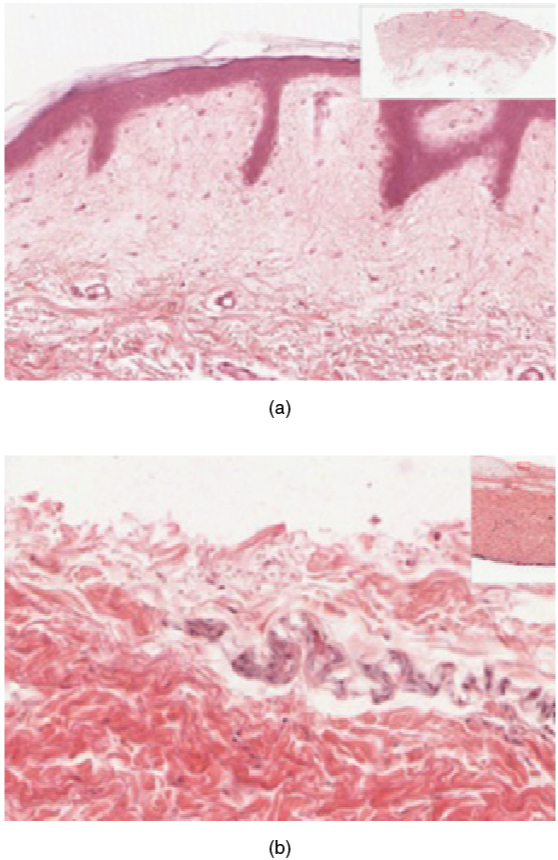
The cells in all of the layers except the stratum basale are called . Keratin is an intracellular fibrous protein that gives hair, nails, and skin their hardness and water-resistant properties. The keratinocytes in the stratum corneum are dead and regularly slough away, being replaced by cells from the deeper layers (see Figure 6.3).
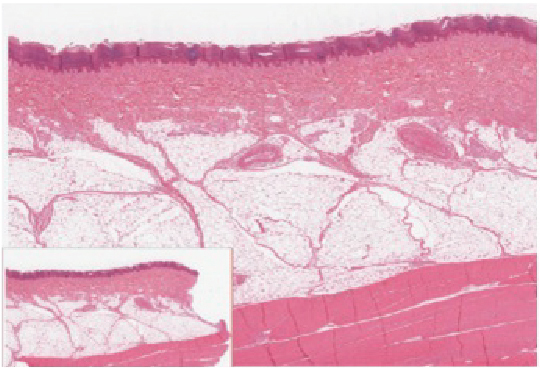
Dermis
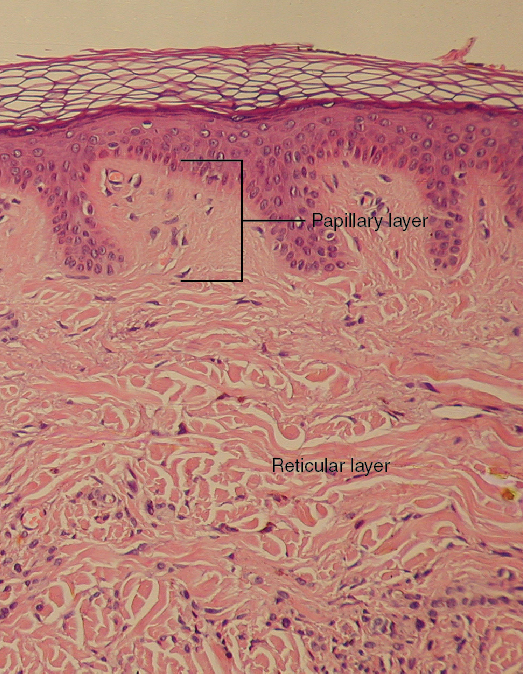
Papillary Layer
The papillary layer is made of loose, areolar connective tissue, which means the collagen and elastin fibers of this layer course a loose mesh. This superficial layer of the dermis projects into the stratum basale of the epidermis to form finger-like dermal papillae (see Effigy six.4). Within the papillary layer are fibroblasts, a modest number , and an affluence of modest blood vessels. In addition, the papillary layer contains , that help fight bacteria or other infections that take breached the skin. This layer too contains lymphatic capillaries, nerve fibers, and .
Reticular Layer
Underlying the papillary layer is the much thicker reticular layer, composed of dense, irregular connective tissue. This layer is well and has a rich sensory and nervus supply. The reticular layer appears due to a tight meshwork of fibers. Elastin fibers provide some elasticity to the skin, enabling movement. Collagen fibers provide structure and tensile strength, with strands of collagen extending into both the papillary layer and the hypodermis. In addition, collagen binds water to keep the skin hydrated. Collagen injections and Retin-A creams help restore skin turgor by either introducing collagen externally or stimulating blood flow and repair of the dermis, respectively.
Hypodermis
The serves to connect the peel to the underlying of the bones and muscles. It is non strictly a part of the skin, although the border between the and can exist difficult to distinguish. The hypodermis consists of well-vascularized, loose, areolar connective tissue and tissue, which functions as a mode of fat storage and provides insulation and cushioning for the integument.
Do labeling the layers of the peel.
Physiology (Function) of the Integumentary System
The skin and accessory structures perform a multifariousness of essential functions, such equally protecting the body from invasion by microorganisms, chemicals, and other environmental factors; preventing dehydration; acting equally a sensory organ; modulating body temperature and electrolyte balance; and synthesizing vitamin D. The underlying hypodermis has important roles in storing fats, forming a "absorber" over underlying structures, and providing insulation from cold temperatures.
Protection
The pare protects the body from wind, water, and UV sunlight. Information technology acts every bit a protective bulwark against h2o loss and it also is the offset line of defense against abrasive action such as grit, microbes, or harmful chemicals. Sweat excreted from sweat glands deters microbes from over-colonizing the peel surface by generating dermicidin, which has antibiotic properties.
Sensory Function
The skin acts equally a sense organ because the epidermis, dermis, and the hypodermis contain specialized sensory nervus structures that find bear on, surface temperature, and pain. These receptors are more concentrated on the tips of the fingers, which are most sensitive to touch, especially the , which responds to lite bear on, and the , which responds to vibration. Merkel cells, seen scattered in the stratum basale, are also impact receptors. In add-on to these specialized receptors, there are sensory nerves connected to each hair follicle, pain and temperature receptors scattered throughout the pare, and motor nerves innervate the arrector pili muscles and glands. This rich innervation helps us sense our environment and react accordingly,
Thermoregulation
The integumentary arrangement helps regulate body temperature through its tight clan with the . The sympathetic nervous system is continuously monitoring trunk temperature and initiating appropriate motor responses.
- When the body becomes warm sweat glands, accessory structures to the skin, secrete water, common salt, and other substances to cool the torso.
- Even when the trunk does not appear to exist noticeably sweating, approximately 500 mL of sweat are secreted a 24-hour interval.
- If the body becomes excessively warm due to high temperatures, vigorous activity, or a combination of the two, sweat glands will be stimulated by the sympathetic nervous arrangement to produce large amounts of sweat.
- When the sweat evaporates from the skin surface, the torso is cooled as torso heat is prodigal.
- In addition to sweating, arterioles in the dermis dilate so that excess estrus carried past the blood tin can dissipate through the skin and into the surrounding environment (Figure 2b).
- This accounts for the skin redness that many people feel when exercising.
- When body temperatures drop, the arterioles constrict to minimize estrus loss, particularly in the ends of the digits and tip of the nose.
- This reduced circulation can result in the pare taking on a whitish hue.
- Although the temperature of the peel drops as a result, passive oestrus loss is prevented, and internal organs and structures remain warm.
- If the temperature of the skin drops too much (such every bit environmental temperatures below freezing), the conservation of torso core heat tin can result .
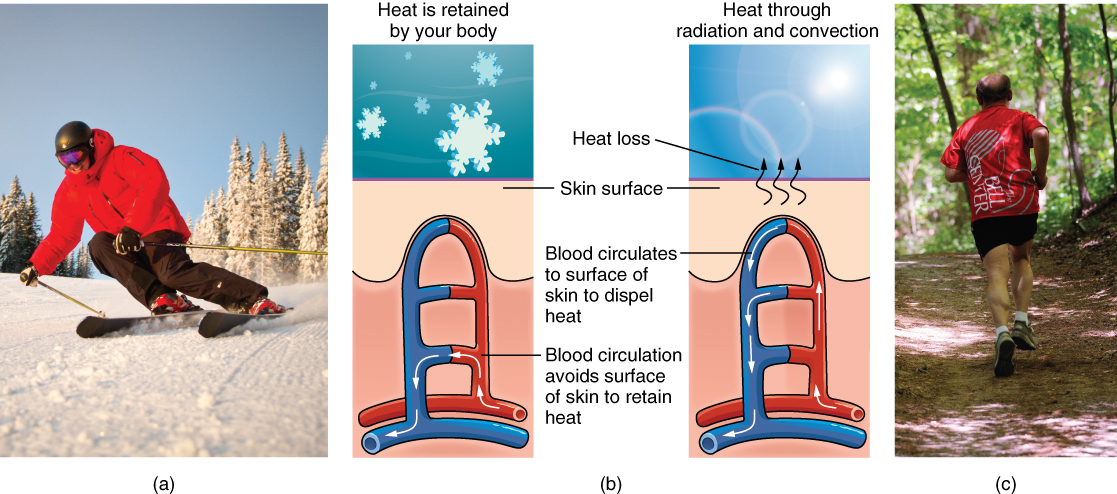
Can you describe the thermoregulation process betwixt the integumentary system and the sympathetic organisation?
- When body temperature is too warm.
- When body temperature is too cold.
Vitamin D Synthesis
The epidermal layer of human being pare synthesizes Vitamin D when exposed to UV radiation. In the presence of sunlight, a form of Vitamin D3 chosen cholecalciferol is synthesized from a derivative of the steroid cholesterol in the skin. The liver converts cholecalciferol to calcidiol, which is then converted to calcitriol (the active chemical form of the vitamin) in the kidneys.
- Vitamin D is essential for normal absorption of calcium and phosphorous, which are required for healthy bones.
- The absence of dominicus exposure can atomic number 82 to a lack of vitamin D in the body, in children this can cause . Vitamin D deficiency in elderly individuals may lead to .
- In nowadays mean solar day gild, Vitamin D is added every bit a supplement to many foods, including milk and orange juice, compensating for the demand for sun exposure. In addition to its essential role in bone health, Vitamin D is essential for full general immunity against bacterial, viral, and fungal infections.
Sentinel this video:
Media half-dozen.2. The Integumentary System, Part two – Skin Deeper: Crash Course A&P #7 [Online video]. Copyright 2022 past CrashCourse.
Accompaniment Structures
Accessory structures of the skin include hair, nails, sweat glands, and sebaceous glands. These structures embryologically originate from the epidermis and can extend downwardly through the dermis into the .
Hair
Hair is a keratinous filament growing out of the . It is primarily made of expressionless, keratinized cells. Strands of pilus originate in an epidermal penetration of the dermis called the hair follicle. The hair shaft is the office of the pilus not anchored to the follicle, and much of this is exposed at the skin's surface. The rest of the hair, which is anchored in the follicle, lies beneath the surface of the skin and is referred to every bit the hair root. The pilus root ends deep in the dermis at the hair bulb, and includes a layer of mitotically active basal cells chosen the pilus matrix. The hair seedling surrounds the hair papilla, which is made of connective tissue and contains blood capillaries and nerve endings from the dermis (see Figure half-dozen.vi).
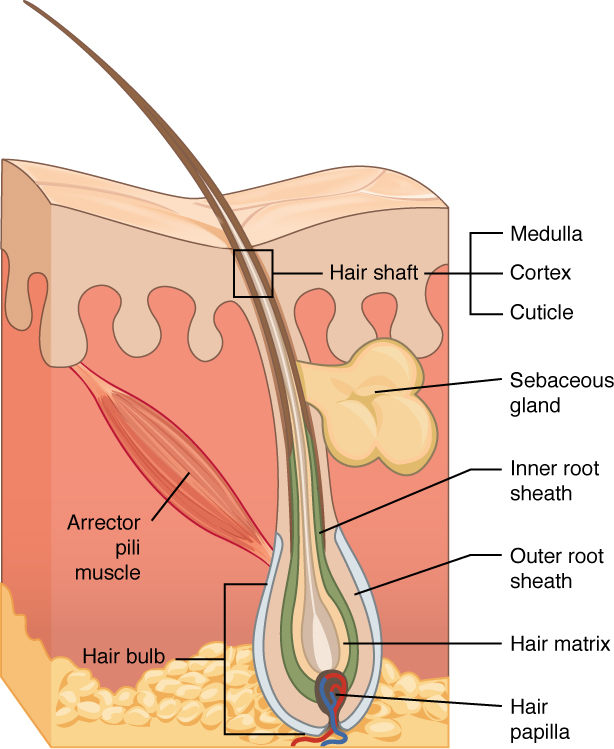
Hair Function
Hair serves a multifariousness of functions, including protection, sensory input, thermoregulation, and advice. For instance:
- Hair on the caput protects the skull from the sunday.
- Hair in the nose and ears, and around the optics (eyelashes) defends the body by trapping and excluding dust particles that may incorporate allergens and microbes.
- Hair of the eyebrows prevents sweat and other particles from dripping into and bothering the eyes.
Hair likewise has a sensory function due to sensory innervation by a hair root plexus surrounding the base of each hair follicle. Pilus is extremely sensitive to air movement or other disturbances in the surround, much more so than the skin surface. This feature is as well useful for the detection of the presence of insects or other potentially damaging substances on the skin surface.
Each hair root is connected to a shine muscle called the arrector pili that contracts in response to nerve signals from the sympathetic nervous organization, making the external hair shaft "stand upwards." The primary purpose for this is to trap a layer of air to add insulation. This is visible in humans every bit goose bumps and even more obvious in animals, such equally when a frightened true cat raises its fur. Of course, this is much more than obvious in organisms with a heavier coat than most humans, such as dogs and cats.
Hair Growth, Loss and Colour
Hair grows and is eventually shed and replaced past new hair. Hair typically grows at the rate of 0.3 mm per twenty-four hour period. On boilerplate, 50 hairs are lost and replaced per day. Pilus loss occurs if there is more hair shed than what is replaced and can happen due to hormonal or dietary changes. Hair loss tin besides event from the aging procedure, or the influence of hormones. Similar to the peel, hair gets its colour from the pigment melanin, produced past in the hair papilla. Unlike hair color results from differences in the blazon of melanin. As a person ages, the melanin production decreases, and hair tends to lose its color and becomes greyness and/or white.
Nails
The nail bed is a specialized construction of the epidermis that is found at the tips of our fingers and toes. The nail torso is formed on the nail bed, and protects the tips of our fingers and toes every bit they are the uttermost extremities and the parts of the body that experience the maximum mechanical stress (encounter Figure 6.7). The nail trunk forms a dorsum-support for picking up small objects with the fingers. The nail body is composed of densely packed dead .
The epidermis in this office of the body has evolved a specialized structure upon which nails tin form. The blast body forms at the nail root, which has a matrix of proliferating cells from the stratum basale that enables the smash to grow continuously. The lateral nail fold overlaps the nail on the sides, helping to anchor the boom body. The nail fold that meets the proximal end of the nail body forms the blast cuticle, also called the eponychium.
The nail bed is rich in claret vessels, making it appear pinkish, except at the base of operations, where a thick layer of epithelium over the nail matrix forms a crescent-shaped region called the lunula (the "piddling moon"). The surface area beneath the gratis edge of the smash, furthest from the cuticle, is called the hyponychium. It consists of a thickened layer of stratum corneum.

Sweat Glands
Sudoriferous Glands
When the trunk becomes warm, sudoriferous glands produce sweat to cool the body. Sweat glands develop from epidermal projections into the dermis and are classified as merocrine glands; that is, the secretions are excreted past through a duct without affecting the cells of the gland. There are two types of sweat glands, each secreting slightly unlike products.
An eccrine sweat gland is type of gland that produces a hypotonic sweat for thermoregulation as described previously. These glands are found all over the pare's surface, but are especially abundant on the palms of the hand, the soles of the feet, and the brow (Figure 6.eight). They are coiled glands lying deep in the dermis, with the duct ascent up to a pore on the peel surface, where the sweat is released. This type of sweat, released by , is hypotonic and equanimous mostly of water, with some table salt, antibodies, traces of metabolic waste material, and dermicidin, an antimicrobial peptide. Eccrine glands are a primary component of thermoregulation in humans and thus help to maintain .
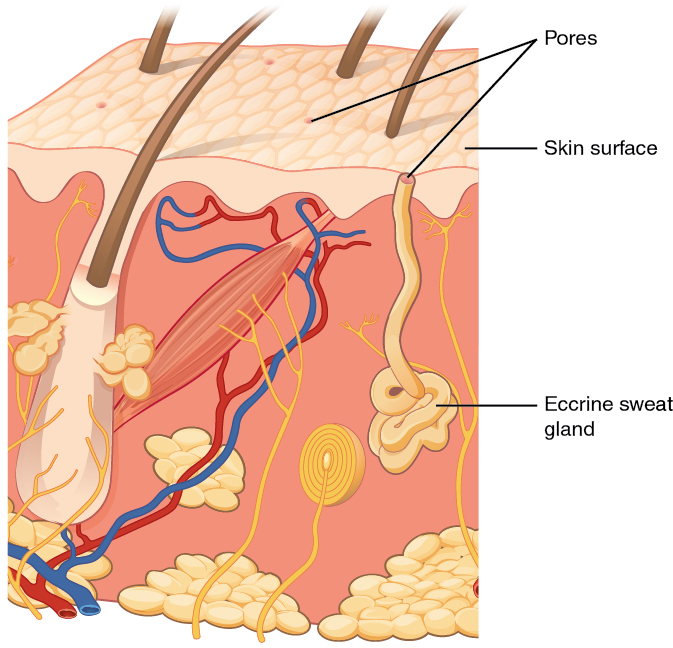
An apocrine sweat gland is usually associated with hair follicles in densely hairy areas, such as armpits and genital regions. Apocrine sweat glands are larger than eccrine sweat glands and lie deeper in the dermis, sometimes even reaching the hypodermis, with the duct usually emptying into the hair follicle. In addition to water and salts, apocrine sweat includes organic compounds that make the sweat thicker and subject to bacterial decomposition and subsequent olfactory property. The release of this sweat is nether both nervous and hormonal command, and plays a role in the poorly understood human being pheromone response. About commercial antiperspirants utilize an aluminum-based compound as their primary active ingredient to stop sweat. When the antiperspirant enters the sweat gland duct, the aluminum-based compounds precipitate due to a change in pH and form a concrete block in the duct, which prevents sweat from coming out of the pore.
Sebaceous Glands
A sebaceous gland is a blazon of oil gland that is found all over the body and helps to lubricate and waterproof the pare and pilus. Well-nigh sebaceous glands are associated with pilus follicles. They generate and excrete sebum, a mixture of lipids, onto the peel surface, thereby naturally lubricating the dry out and dead layer of keratinized cells of the stratum corneum, keeping information technology pliable. The fat acids of sebum also have antibacterial backdrop, and prevent h2o loss from the skin in depression-humidity environments. The secretion of sebum is stimulated by hormones, many of which do not become active until puberty. Thus, sebaceous glands are relatively inactive during childhood.
Words not Easily Broken into Word Parts
Common Integumentary System Abbreviations
Many terms and phrases related to the integumentary system are abbreviated. Learn these common abbreviations by expanding the list below.
Changes Due to Crumbling
All systems in the body accumulate subtle and some not-then-subtle changes as a person ages. Amongst these changes are reductions in cell sectionalization, metabolic activity, blood circulation, hormonal levels, and muscle strength (see Figure half dozen.9). In the skin, these changes are reflected in decreased mitosis in the stratum basale, leading to a thinner epidermis. The dermis, which is responsible for the elasticity and resilience of the pare, exhibits a reduced ability to regenerate, which leads to slower wound healing. The hypodermis, with its fat stores, loses structure due to the reduction and redistribution of fat, which in turn contributes to the thinning and sagging of skin.
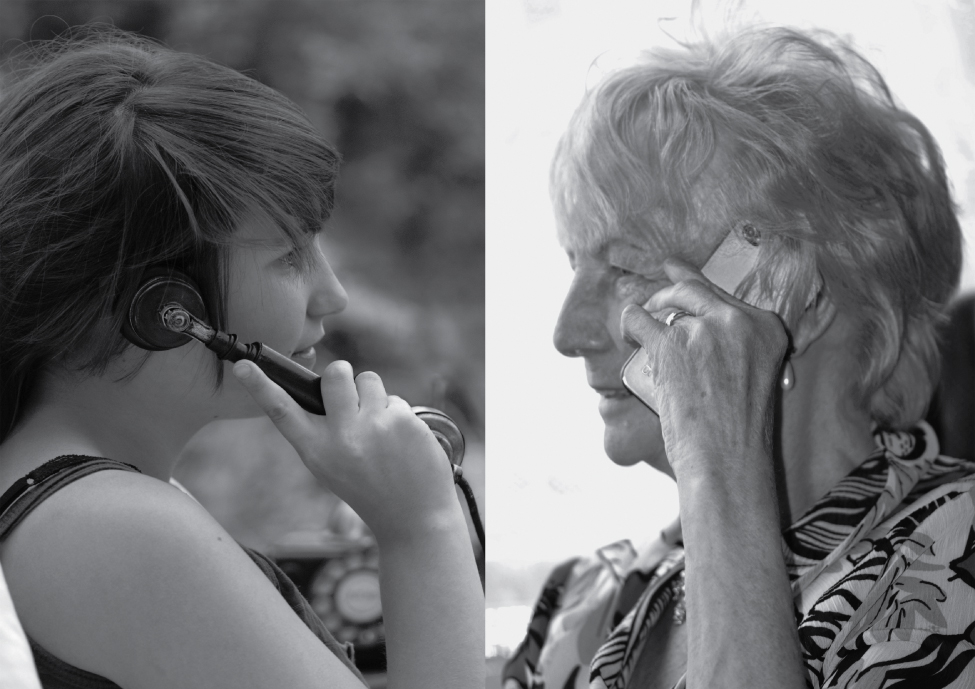
The accessory structures also have lowered activeness, generating thinner hair and nails, and reduced amounts of sebum and sweat. A reduced sweating power can cause some elderly to be intolerant to extreme heat. Other cells in the skin, such equally and cells, likewise become less active, leading to a paler skin tone and lowered amnesty. Wrinkling of the skin occurs due to breakdown of its structure, which results from decreased collagen and elastin product in the dermis, weakening of muscles lying nether the skin, and the inability of the pare to retain acceptable moisture.
Illness and Disorders
The integumentary system is susceptible to a diversity of diseases, disorders, and injuries. These range from annoying but relatively benign bacterial or fungal infections that are categorized as disorders, to skin cancer and severe burns, which can be fatal. In this section, you will learn several of the almost common peel conditions.
I of the virtually talked near diseases is skin . Most cancers are identified past the organ or tissue in which the cancer originates. I mutual course of cancer is skin cancer.
In general, cancers issue from an accumulation of DNA mutations. These mutations can result in cell populations that do not dice when they should and uncontrolled cell proliferation that leads to tumors. Although many tumors are , some . Cancers are characterized past their ability to metastasize.
Sun Harm
It requires about ten days later on initial sun exposure for melanin synthesis to peak, which is why stake-skinned individuals tend to endure sunburns of the epidermis initially. Dark-skinned individuals tin can also get sunburns, but are more than protected than are pale-skinned individuals. Too much dominicus exposure tin eventually pb to wrinkling due to the destruction of the cellular structure of the skin, and in severe cases, can crusade sufficient Dna damage to result in pare cancer. When there is an irregular accumulation of melanocytes in the peel, freckles appear. Moles are larger masses of melanocytes, and although most are benign, they should be monitored for changes that might indicate the presence of cancer (meet Figure 6.x).
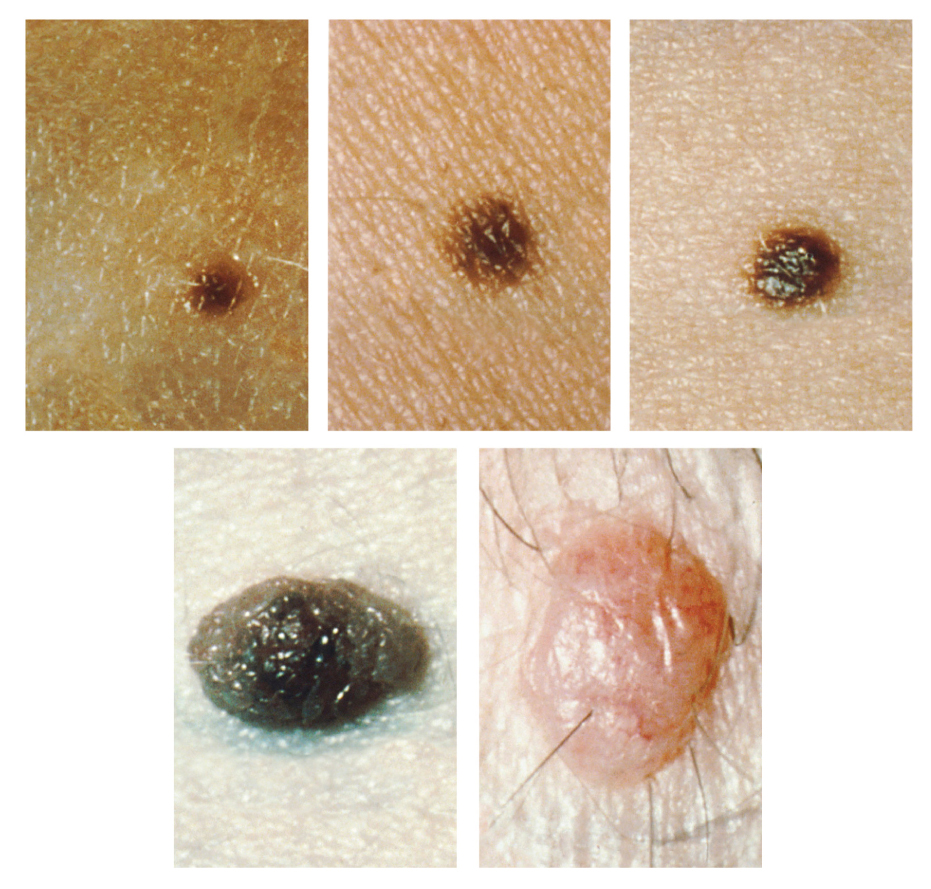
Basal Cell Carcinoma (BCC)
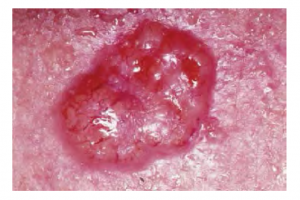
Basal jail cell carcinoma is a form of cancer that affects the mitotically active stem cells in the stratum basale of the epidermis. It is the most common of all cancers that occur in the United States and is frequently plant on the head, neck, arms, and back, which are are as that are most susceptible to long-term lord's day exposure. Although UV rays are the primary culprit, exposure to other agents, such as radiation and arsenic, tin also lead to this type of cancer. Wounds on the skin due to open sores, tattoos, burns, etc. may be predisposing factors. Basal prison cell carcinomas beginning in the stratum basale and usually spread forth this boundary. At some point, they begin to grow toward the surface and get an uneven patch, crash-land, growth, or scar on the pare surface (see Figure vi.11). Like most cancers, basal cell carcinomas respond best to treatment when caught early on. Handling options include surgery, freezing (cryosurgery), and topical ointments.
Squamous Cell Carcinoma (SCC)
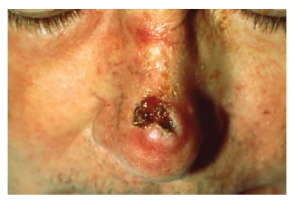
Squamous cell carcinoma is a cancer that affects the keratinocytes of the stratum spinosum and presents as lesions commonly found on the scalp, ears, and easily (meet Figure 6.12). Information technology is the second well-nigh common pare cancer. The American Cancer Lodge reports that ii of 10 pare cancers are squamous jail cell carcinomas, and it is more aggressive than basal cell carcinoma. If non removed, these carcinomas can . Surgery and radiation are used to cure squamous cell carcinoma.
Melanoma
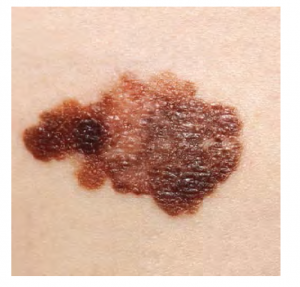
A melanoma is a cancer characterized by the uncontrolled growth of melanocytes, the pigment-producing cells in the epidermis. Typically, a melanoma develops from a mole. It is the virtually fatal of all pare cancers, as it is highly metastatic and can be difficult to detect earlier it has spread to other organs. Melanomas usually appear as asymmetrical brown and black patches with uneven borders and a raised surface (see Figure six.13). Handling typically involves surgical excision and immunotherapy.
ABCDE for Early Diagnosis
Doctors often give their patients the post-obit ABCDE mnemonic to assist with the diagnosis of early-stage melanoma. If y'all observe a mole on your body displaying these signs, consult a dr..
Asymmetry – the ii sides are not symmetrical
Borders – the edges are irregular in shape
Color – the color is varied shades of chocolate-brown or blackness
Diameter – information technology is larger than 6 mm (0.24 in)
Evolving – its shape has changed
Some specialists cite the following additional signs for the most serious grade, nodular melanoma:
Elevated – it is raised on the skin surface
Firm – it feels hard to the touch
Growing – information technology is getting larger
Albinism
Albinism is a genetic disorder that affects (completely or partially) the coloring of peel, pilus, and optics. This is primarily due to the inability of melanocytes to produce melanin. Individuals with albinism tend to appear white or very pale due to the lack of melanin in their skin and hair. Call back that melanin helps protect the skin from the harmful effects of UV radiations. Individuals with albinism tend to need more protection from UV radiation, as they are more than decumbent to sunburns and skin cancer. They also tend to be more than sensitive to light and take vision issues due to the lack of pigmentation on the retinal wall (Betts, et al., 2022)
Treatment of this disorder usually involves addressing the symptoms, such equally limiting UV light exposure to the skin and optics. In vitiligo , the melanocytes in certain areas lose their ability to produce melanin, perchance due to an autoimmune reaction. This leads to a loss of color in patches (come across Figure 6.xiv). Neither albinism nor vitiligo directly affects the lifespan of an private (Betts, et al., 2022)
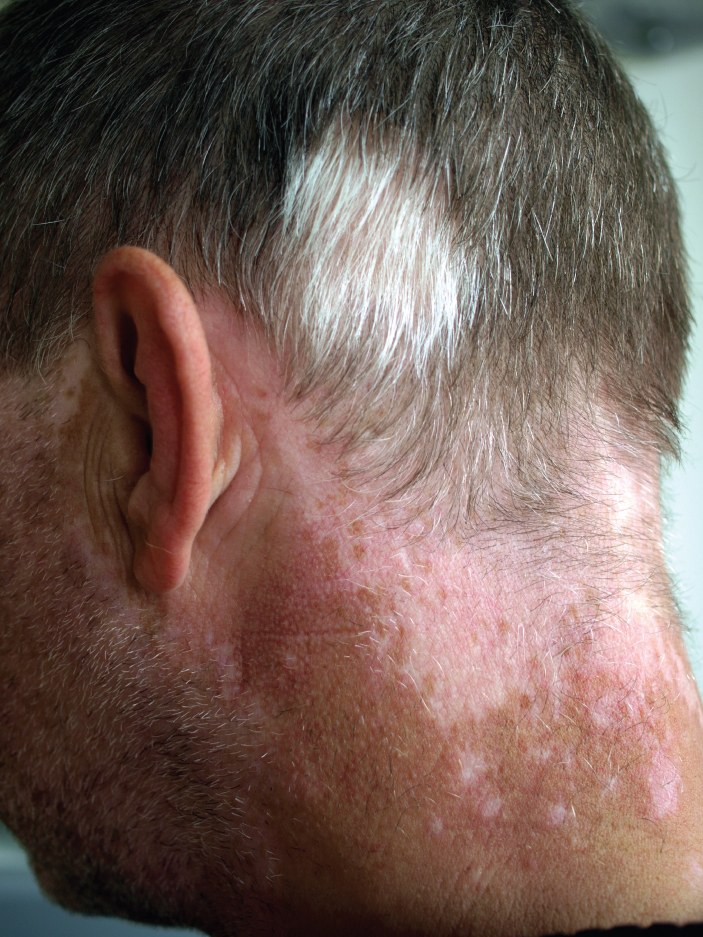
Changes in Skin Colouration
Other changes in the appearance of pare colouration tin be indicative of diseases associated with other body systems.
- Liver illness or liver cancer can cause the accumulation of bile and the xanthous paint bilirubin, leading to the pare appearing yellow or .
- Tumors of the pituitary gland tin result in the secretion of large amounts of melanocyte-stimulating hormone (MSH), which results in a darkening of the skin.
- Addison'south disease can stimulate the release of excess amounts of adrenocorticotropic hormone (ACTH), which can give the peel a deep bronze color
- A sudden drop in oxygenation tin affect skin color, causing the skin to initially turn ashen (white).
- A prolonged reduction in oxygen levels, dark red deoxyhemoglobin becomes dominant in the blood, making the skin appear blue, a condition referred to equally . This happens when the oxygen supply is restricted, every bit when someone is experiencing difficulty in breathing because of asthma or a middle set on. However, in these cases the upshot on skin color has zippo practise with the skin'southward pigmentation (Betts, et al., 2022)
Pare Disorders
2 common skin disorders are eczema and acne. Eczema is an inflammatory condition and occurs in individuals of all ages. Acne involves the bottleneck of pores, which can lead to infection and inflammation, and is often seen in adolescents. Other disorders, include seborrheic dermatitis (on the scalp), psoriasis, fungal infections, cold sores, impetigo, scabies, hives, and warts (Betts, et al., 2022).
Eczema
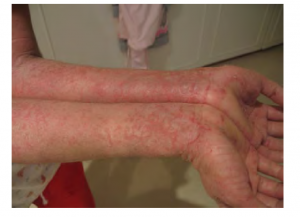
Eczema is an allergic reaction that manifests every bit dry, itchy patches of peel that resemble rashes (see Figure half-dozen.fifteen). It may be accompanied past swelling of the skin, flaking, and in severe cases, bleeding. Symptoms are ordinarily managed with moisturizers, corticosteroid creams, and immunosuppressants (Betts, et al., 2022).
Acne
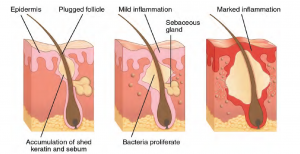
Acne is a skin disturbance that typically occurs on areas of the pare that are rich in sebaceous glands (face and back). It is nigh common along with the onset of puberty due to associated hormonal changes, only can also occur in infants and continue into adulthood. Hormones, such every bit androgens, stimulate the release of sebum. An overproduction and accumulation of sebum along with keratin can block hair follicles. This plug is initially white. The sebum, when oxidized by exposure to air, turns black. Acne results from infection past acne-causing bacteria (Propionibacterium and Staphylococcus), which can lead to redness and potential scarring due to the natural wound healing process (see Effigy 6.16) (Betts, et al., 2022).
Ringworm
Tinea or dermatophytosis is often referred to as ringworm. Ringworm presents equally a circular rash that is itchy and crimson and can be found on various parts of the body. It is referred to by the location that information technology is establish:
-
- Tinea Pedis – feet or normally referred to as athlete'due south feet
- Tinea Capitis – scalp
- Tinea barbae – beard
- Tinea manuum – hands
- Tinea unguium – Toenails and fingernails also called onychomycosis
- Tinea corporis – Torso parts such as arms and legs (Center for Disease Control and Prevention, 2022a)
To learn more about ringworm, visit the Eye for Disease Command and Prevention's spider web page on fungal infections.
Psoriasis
Psoriasis is a chronic autoimmune disorder that results in patches of thick red skin with the advent of silvery scales. These patches can be found on elbows, knees, scalp, low dorsum, confront, feet, fingernails, toenails and fifty-fifty the mouth. Psoriasis tin be confused with other pare affliction and so a dermatologist is the best physician to diagnosis psoriasis. Treatments may include creams, ointments, ultraviolet lite therapy and medication (Centre for Affliction Command and Prevention, 2022). To learn more, visit the Center for Disease Command and Prevention's spider web page on psoriasis.
Injuries
Skin injuries ready off a healing process that occurs in several overlapping stages.
- The showtime footstep to repairing damaged skin is the formation of a blood clot that helps cease the flow of claret and scabs over with time. Many unlike types of cells are involved in wound repair, especially if the surface expanse that needs repair is extensive.
- Before the basal stem cells of the stratum basale tin can recreate the epidermis, fibroblasts mobilize and divide rapidly to repair the damaged tissue by collagen deposition, forming granulation tissue.
- Blood capillaries follow the fibroblasts and assist increase blood apportionment and oxygen supply to the area.
- Immune cells, such as macrophages, roam the area and engulf any strange matter to reduce the risk of infection (Betts, et al., 2022).
Burns
A burn down results when the skin is damaged by intense oestrus, radiation, electricity, or chemicals. The damage results in the death of peel cells, which can lead to a massive loss of fluid. Dehydration, electrolyte imbalance, and renal and circulatory failure follow, which can be fatal. Burn patients are treated with intravenous fluids to offset , as well as nutrients that enable the body to repair tissues and supplant lost proteins. Another serious threat to the lives of fire patients is . Burned skin is extremely susceptible to bacteria and other , due to the loss of protection past intact layers of skin (Betts, et al., 2022).
Burn Classification
Burns are sometimes measured in terms of the size of the total area affected. This is referred to as the rule of nines, which associates specific anatomical areas with a percentage that is a gene of ix (come across Figure half dozen.17) (Betts, et al., 2022).
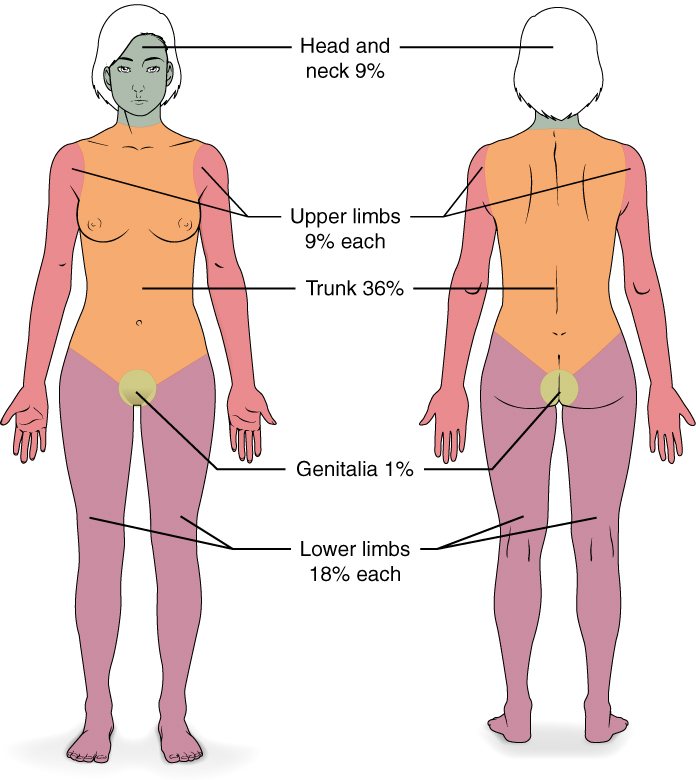
Burns are also classified by the caste of their severity.
- A first-caste burn is a superficial burn down that affects only the epidermis. Although the pare may be painful and swollen, these burns typically heal on their ain within a few days. Balmy sunburn fits into the category of a beginning-degree burn.
- A 2d-degree burn goes deeper and affects both the epidermis and a portion of the dermis. These burns upshot in swelling and a painful baking of the skin. It is important to keep the burn site clean and sterile to prevent infection. If this is done, the burn will heal within several weeks.
- A third-degree burn fully extends into the epidermis and dermis, destroying the tissue and affecting the nerve endings and sensory function. These are serious burns that may appear white, cherry, or black; they require medical attention and will heal slowly without it.
- A fourth-degree burn is fifty-fifty more severe, affecting the underlying muscle and bone.
Oddly, 3rd and quaternary-degree burns are usually not as painful because the nerve endings themselves are damaged. Full-thickness burns cannot be repaired by the body, because the local tissues used for repair are damaged and require , or amputation in severe cases, followed by grafting of the skin from an unaffected part of the body, or from skin grown in tissue culture for grafting purposes. Peel grafts are required when the harm from trauma or infection cannot be airtight with sutures or staples (Betts et al., 2022).
Scars and Keloids
Well-nigh cuts or wounds, with the exception of ones that only scratch the epidermis, lead to formation. Scarring occurs in cases in which there is repair of pare damage, only the pare fails to regenerate the original skin structure. Fibroblasts generate scar tissue in the class of collagen, and the majority of repair is due to the basket-weave design generated by collagen fibers and does not effect in regeneration of the typical cellular structure of skin. Instead, the tissue is fibrous in nature and does non allow for the regeneration of accessory structures, such equally hair follicles, sweat glands, or sebaceous glands (Betts, et al., 2022).
Sometimes, there is an overproduction of scar tissue, because the process of collagen formation does non finish when the wound is healed; this results in a . In dissimilarity, scars that result from acne and chickenpox accept a sunken advent and are called atrophic scars (Betts, et al., 2022)
Scarring of skin afterwards wound healing is a natural process and does non need to be treated further. Application of mineral oil and lotions may reduce the formation of scar tissue. Still, mod cosmetic procedures, such as dermabrasion, laser treatments, and filler injections have been invented equally remedies for severe scarring. All of these procedures try to reorganize the structure of the epidermis and underlying collagen tissue to make it look more than natural (Betts, et al., 2022).
Bedsores and Stretch Marks
Peel and its underlying tissue tin can be affected by excessive pressure level. 1 instance of this is chosen a bedsore. Bedsores, also chosen decubitus ulcers, are caused by abiding, long-term, unrelieved force per unit area on certain body parts that are bony, reducing claret flow to the expanse and leading to . Bedsores are most mutual in elderly patients who have debilitating conditions that cause them to be immobile. Nearly hospitals and long-term care facilities take the practice of turning the patients every few hours to foreclose the incidence of bedsores. If left untreated bedsores can be fatal if they become infected (Betts, et al., 2022)
The skin can also be afflicted past pressure associated with rapid growth. A stretch marking results when the dermis is stretched beyond its limits of elasticity, as the pare stretches to suit the backlog pressure. Stretch marks usually accompany rapid weight gain during puberty and pregnancy. They initially have a ruby-red hue, but lighten over fourth dimension. Other than for corrective reasons, handling of stretch marks is not required. They occur about normally over the hips and abdomen (Betts, et al., 2022).
Calluses
When you wear shoes that do not fit well and are a constant source of abrasion on your toes, you tend to course a callus at the signal of contact. This occurs because the basal stem cells in the stratum basale are triggered to divide more often to increase the thickness of the pare at the indicate of abrasion to protect the remainder of the trunk from further impairment. This is an example of a minor or local injury, and the peel manages to react and care for the problem independent of the remainder of the body. Calluses tin besides form on your fingers if they are field of study to constant mechanical stress, such as long periods of writing, playing cord instruments, or video games. A corn is a specialized form of callus. Corns form from abrasions on the pare that result from an elliptical-type motion (Betts, et al., 2022).
Medical Terms in Context
Medical Specialties and Procedures Related to the Integumentary System
A dermatologist is a medical doctor with specialized training in treating diseases, disorders and injuries related to the integumentary system and its accessory structures. At that place are many subspecialties such as cosmetic dermatology, and pediatric dermatology. To learn more visit the Dermatology and Subspecialties section of the Canadian Dermatology Association website.
Dermatologists tin exist specially trained to perform a process chosen Mohs surgery. Mohs surgery skin cancers in thin layers until all cancer is removed from the tissue (Mayo Clinic Staff, 2022).
Integumentary System Vocabulary
Adipocytes
Fat cells.
Adipose tissue
Fatty tissue.
Autonomic nerve fibers
Unconsciously regulates communication to and from the brain.
Avascular
Without blood vessels.
Benign
Noncancerous, harmless.
Cancer
A process where aberrant cells in the body separate uncontrollably.
Cyanosis
Aberrant condition of blue (blue color, lips and nail beds). Typically caused past depression oxygenation.
Debridement
Excision of damaged tissue or foreign object.
Dehydration
Loss of fluids/water is greater than what is taken in.
Dermatologic
Pertaining to dermatology.
Dermatopathology
Study of diseases of the skin.
Dermis
The layer of skin that is made of dumbo, irregular connective tissue that houses claret vessels, hair follicles, sweat glands, and other structures.
Epidermis
Outer layer of skin, made of closely packed epithelial cells.
Excises
Remove by cutting out.
Exocytosis
Agile transport of molecules out of the cell.
Fascia
Fibrous tissue.
Frostbite
Conservation of cadre body heat results in the skin actually freezing.
Hypodermis
Literally ways below the dermis. The layer of skin below the dermis that is composed mainly of loose connective and fatty tissues.
Infection
Invasion by disease-causing organisms.
Intravenous
Pertaining to within the vein.
Jaundiced
Yellow-coloured.
Keloid
Formation of a raised or hypertrophic scar.
Keratinocytes
Cells that manufacture and shop the poly peptide keratin.
Meissner corpuscle
Tactile corpuscle that responds to light and affect, touch receptor.
Meissner corpuscles
Tactile corpuscle that responds to low-cal and affect, impact receptors.
Melanocytes
Specialized cells that produce melanin which is a night paint responsible for colouration of skin and hair.
Metastasize
Product of cells that tin mobilize and found tumors in other organs of the body.
Necrosis
Tissue death.
Osteomalacia
Softening of the bones.
Pacinian corpuscle
Lamellated corpuscle that responds to vibration.
Pathogens
Disease-causing agents.
Phagocytes
Cells that engulf and blot leaner and cell particles.
Reticulated
Net like.
Rickets
A painful status in children where bones are misshapen due to a lack of calcium, causing bow leggedness.
Scar
Collagen-rich peel formed after the process of wound healing that differs from normal peel.
Stratum Basale
Deepest layer of the epidermal.
Sympathetic nerve fibers
Flight or fight response determines communication to and from the encephalon.
Sympathetic Nervous Organisation
Responsible for fight or flight responses.
Vascularized
Has numerous blood vessels.
Exam Yourself
References
Centers for Disease Control and Prevention. (2018, October 25). Psoriasis. Centers for Disease Control and Prevention: Fungal Diseases. https://www.cdc.gov/psoriasis/
Centers for Disease Control and Prevention. (2018a, August 6). Ringworm. Centers for Disease Control and Prevention: Fungal Diseases. https://www.cdc.gov/fungal/diseases/ringworm/definition.html
CrashCourse. (2015, Jan 6). The Integumentary organisation, part ane – pare deep: Crash Form A&P #6 [Video]. YouTube. https://youtu.be/Orumw-PyNjw
CrashCourse. (2015, February 16). The Integumentary system, part ii – skin deeper: Crash Course A&P #vii [Video]. YouTube. https://youtu.exist/EN-x-zXXVwQ
Mayo Clinic Staff. (2017, September 6). Mohs surgery. Mayo Clinic. https://world wide web.mayoclinic.org/tests-procedures/mohs-surgery/most/pac-20385222#:~:text=Mohs%20surgery%20is%20a%20precise,known%20as%20Mohs%20micrographic%20surgery.
Image Descriptions
Effigy 6.1 epitome description: This illustration shows a cross section of peel tissue. The outermost layer is chosen the epidermis, and occupies one 5th of the cross section. Several hairs are emerging from the surface. The epidermis dives around one of the hairs, forming a follicle. The middle layer is called the dermis, which occupies four fifths of the cross section. The dermis contains an erector pilli muscle continued to ane of the follicles. The dermis besides contains an eccrine sweat gland, composed of a bunch of tubules. One tubule travels up from the bunch, through the epidermis, opening onto the surface a pore. At that place are 2 string-like fretfulness travelling vertically through the dermis. The right nerve is attached to a Pacinian corpuscle, which is a xanthous structure consisting of concentric ovals like to an onion. The lowest level of the skin, the hypodermis, contains fatty tissue, arteries, and veins. Blood vessels travel from the hypodermis and connect to hair follicles and erector pilli muscle in the dermis. [Return to Figure six.i].
Effigy 6.ii paradigm description: Role A is a micrograph showing a cantankerous section of thin pare. The topmost layer is a thin, translucent layer with irregular texture and areas where cells are sloughing off. The deepest layer is dark purple and extends into the 3rd layer with finger like projections. The 3rd light regal layer contains thin bands of fibers and small, dark cells. The fourth, and deepest layer, is darker than the tertiary layer, but is still light purple. It contains thick cobweb bands that are loosely packed. Part B is a magnified view of the epidermis of thick skin. It shows the topmost layer is five times thicker than the topmost layer of sparse skin. The topmost layer of thick peel is also denser and less translucent than the topmost layer of thin skin. [Return to Figure half-dozen.2].
Figure 6.three epitome description: The outer layer of cells in this micrograph is the thinnest layer and stained deep majestic due to total keratinization of dead cells. The next layer occupies i quarter of the micrograph, is lightly stained, and is a dumbo collection of cells. The third layer from the top is by and large white, with lightly stained, loosely-packed strands radiating in random directions. The bottom-most layer is densely-packed, with thick bands of highly organized muscle tissue that are darkly stained. [Return to Figure 6.three].
Effigy six.4 image description: This micrograph shows layers of skin in a cross section. The papillary layer of the dermis extends between the downward fingers of the darkly stained epidermis. The papillary layer appears effectively than the reticular layer, consisting of smaller, densely-packed fibers. The reticular layer is three times thicker than the papillary layer and contains larger, thicker fibers. The fibers seem more loosely packed than those of the papillary layer, with some separated past empty spaces. Both layers of the dermis contain cells with darkly stained nuclei. [Render to Figure 6.iv].
Effigy six.five image description: Part A is a photo of a homo skiing with several snow-covered copse in the background. Part B is a diagram with a right and left half. The left half is titled " Oestrus is retained by the trunk," while the right half is titled "Heat loss through radiation and convection." Both prove blood flowing from an artery through three capillary beds within the skin. The beds are bundled vertically, with the topmost bed located along the boundary of the dermis and epidermis. The bottommost bed is located deep in the hypodermis. The middle bed is evenly spaced between the topmost and bottommost beds. In each bed, oxygenated claret (red) enters the bed on the left and deoxygenated blood (blue) leaves the bed on the right. The left diagram shows a picture of snowflakes higher up the capillary beds, indicating that the weather is cold. Claret is but flowing through the deepest of the iii capillary beds, as the upper beds are closed off to reduce oestrus loss from the outer layers of the skin. The right diagram shows a pic of the dominicus higher up the capillary beds, indicating that the weather is hot. Blood is flowing through all iii capillary beds, allowing heat to radiate out of the blood, increasing heat loss. Function C is a photo of a man running through a forested trail on a summer twenty-four hour period. [Return to Figure 6.5].
Figure half dozen.6 image description: A cross section of the skin containing a pilus follicle. The follicle is teardrop shaped. Its enlarged base, labeled the pilus seedling, is embedded in the hypodermis. The outermost layer of the follicle is the epidermis, which invaginates from the skin surface to envelope the follicle. Within the epidermis is the outer root sheath, which is only nowadays on the hair bulb. It does not extend up the shaft of the hair. Inside the outer root sheath is the inner root sheath. The inner root sheath extends nearly half of the style up the pilus shaft, ending midway through the dermis. The pilus matrix is the innermost layer. The hair matrix surrounds the bottom of the hair shaft where it is embedded within the hair bulb. The hair shaft, in itself, contains three layers: the outermost cuticle, a middle layer called the cortex, and an innermost layer called the medulla. [Render to Figure six.six].
Figure half dozen.seven image description: The anatomy of the fingernail region. The top epitome shows a dorsal view of a finger. The proximal blast fold is the part underneath where the pare of the finger connects with the edge of the nail. The eponychium is a thin, pink layer between the white proximal border of the blast (the lunula), and the edge of the finger skin. The lunula appears as a crescent-shaped white area at the proximal edge of the pinkish-shaded nail. The lateral nail folds are where the sides of the blast contact the finger skin. The distal edge of the blast is white and is called the free border. An arrow indicates that the nail grows distally out from the proximal nail fold. The lower prototype shows a lateral view of the smash bed beefcake. In this view, one can see how the edge of the smash is located just proximal to the nail fold. This stop of the blast, from which the nail grows, is called the nail root. [Return to Effigy 6.7].
Figure 6.8 paradigm description: An analogy of an eccrine sweat gland embedded in a cross department of pare tissue. The eccrine sweat gland is a bundle of white tubes embedded in the dermis. A unmarried white tube travels upward from the bundle and opens on to the surface of the epidermis. The opening is called a pore. At that place are several pores on the pocket-sized cake of pare portrayed in this diagram. [Render to Figure 6.8].
Figure 6.9 image description: This figure consists of two photos. One photograph shows a young woman on the phone. Her skin is smooth and unwrinkled. The other photograph shows an elderly women in the same posture while on the phone. The skin of her easily and forearms is wrinkled. [Return to Figure vi.ix].
Figure 16.10 prototype description: V photos of moles. The iii upper photos show moles that are minor, flat, and dark brown. The bottom left photo shows a nighttime black mole that is raised above the skin. The bottom right photo shows a large, raised, reddish mole with protruding hairs. [Return to Figure 6.10].
Figure 16.17 image description: This diagram depicts the pct of the full body surface area burned when a victim suffers consummate burns to regions of the body. Complete burning of the face, head and cervix account for xix% of the total trunk area. Burning of the breast, abdomen and entire back above the waist accounts for 36% of the total body expanse. Anterior and posterior surfaces of the arms and hands account for xviii% of the total torso expanse (ix% for each arm). The inductive and posterior surface of both legs, along with the buttocks, accounts for 36% of the total torso area (eighteen% for each leg). Finally, the anterior and posterior surfaces of the genitalia account for 1% of the total body surface area. [Return to Effigy 6.17].
Unless otherwise indicated, this chapter contains fabric adapted from Anatomy and Physiology (on OpenStax), by Betts, et al. and is used under a a CC By 4.0 international license. Download and access this book for costless at https://openstax.org/books/anatomy-and-physiology/pages/1-introduction.
Source: https://ecampusontario.pressbooks.pub/medicalterminology/chapter/integumentary-system/
Posted by: baileyingtheas.blogspot.com


0 Response to "What Is A Medical Term For The Phrase Surgical Repair Of Skin"
Post a Comment